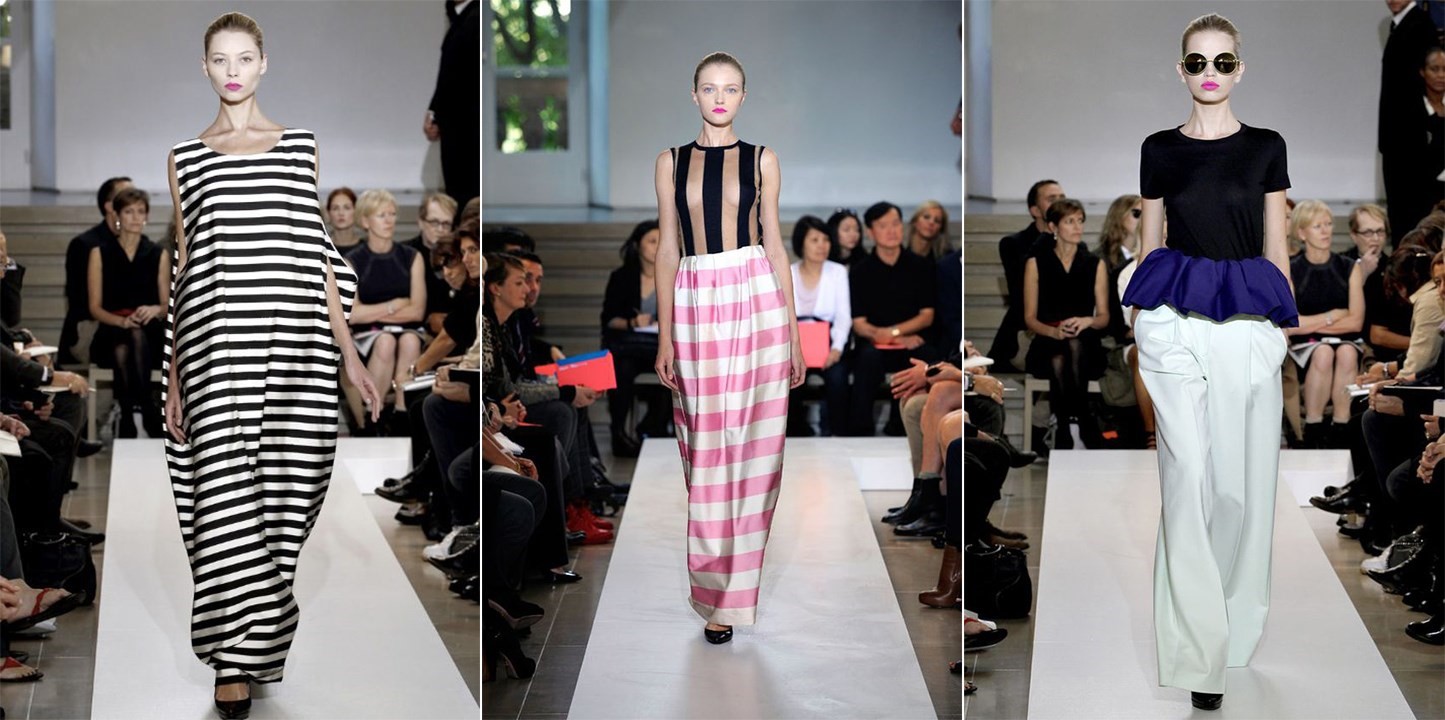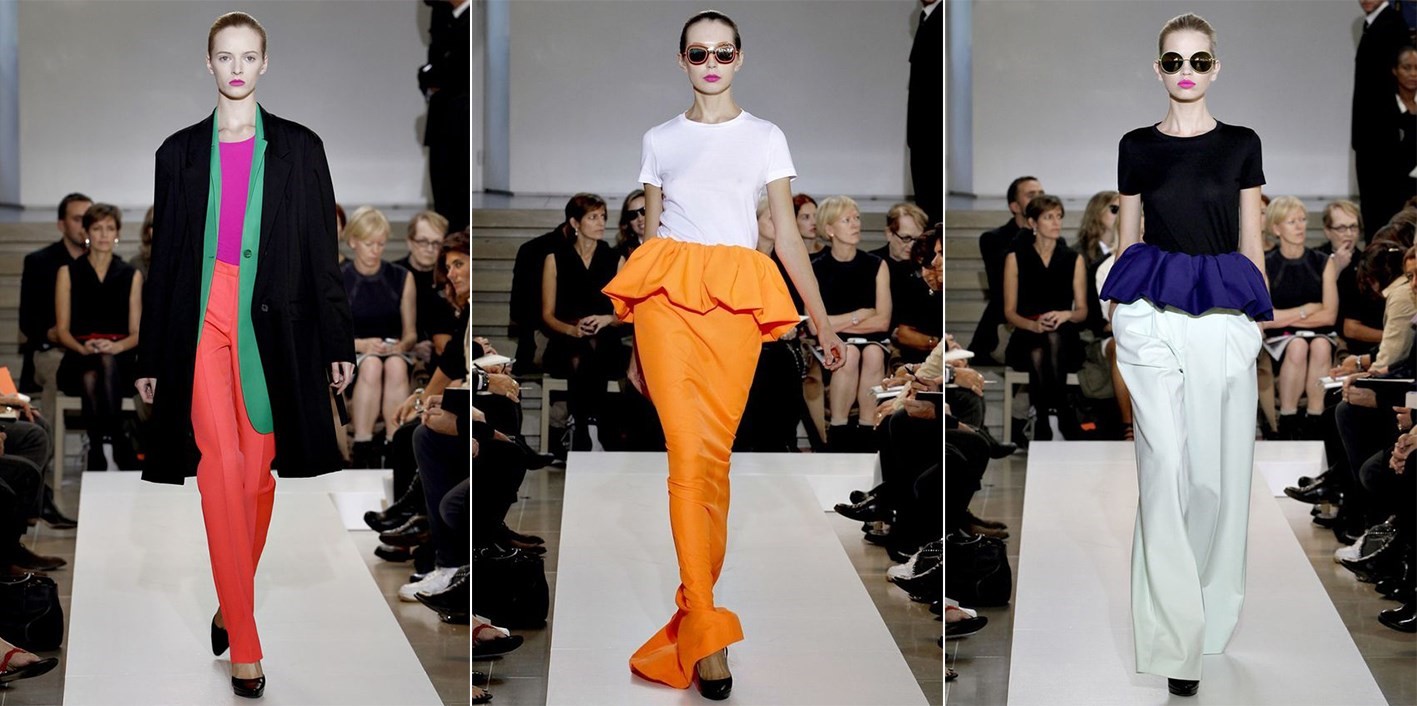Frankfurt’s Museum Angewandte Kunst is currently deifying the legacy of Jil Sander – woman, rather than label – in an ode to minimalism that links Sander’s legacy to German Modernism and Bauhaus notions of form following function. It’s a school of style that has proven profoundly influential both in Sander’s own time as a designer, and after. Everyone, from Céline to COS and all in-between, references Sander’s shtick of the lean, mean and clean.
And yet, under the hand of Raf Simons, who joined the label in 2005, then purely a menswear designer making his first tentative foray into womenswear, the house Jil Sander built enjoyed success and influence that rivalled its founder’s. At least, for the latter part. Simons’ early collections received mixed reviews, as the designer searched through the archive to pull his own story from Sander’s well-worn narrative. However his Spring/Summer 2011 collection, Techno Couture, was a universally acclaimed game-changer for both Simons personally and the industry at large. It kicked his Jil Sander into hyper-coloured hyperdrive, propelling the designer within two years to the plum role of Christian Dior’s storied haute couturier. But the story started at Sander, with Simons’ Spring/Summer 2011 collection, which shifted fashion.
The Show
Staged in the antiseptically white Jil Sander showroom on Milan’s Via Luca Beltrami – a three-floor walk-up from streets sticky and hot in an Italian September – Simons unveiled his collection to a room so packed that the show had to be staged twice (I was at the second one). Unlike his Dior tenure, where blockbuster clothes were twinned with equally impactful catwalk installations comprising millions of blooms, a stained-glass Modernist chapel or, memorably, a tangled tropical greenhouse of real and faux flowers, the Jil Sander shows were generally a stripped-back affair staging-wise. It was the soundtrack that made the first impression at this one, oscillating between the prelude of cinematic composer Bernard Herrmann’s Psycho suite (1960), to Gimme Some More by Busta Rhymes. At the time, the drastic shift from a string-heavy cinematic classic to late-90s hardcore hip-hop was much remarked upon. But perhaps it was intended not just to score but to underscore the collection. In a similar way to Rhymes’ sampling, Simons would take those mid-century couture shapes as the foundation for his own remixing of classic dressing. Or maybe he just liked the way it all sounded. Certainly the music was pumped up as loud as the shocking colour, and volume was important both in the clothes and the soundtrack. In that white space, walls reverberating with the bass, both colours and eardrums popped.

The People
Searching for a new way to interpret the work of Jil Sander, Raf Simons decided to shift away from the label’s signature minimalism. It was a bold move – Sander’s back-catalogue was hot, at that point inspiring Phoebe Philo’s spectacular revival of Céline, and consequently picked over for reference by swathes of copyists. Having already explored the extremes of Bauhaus-style reduction during his five-year tenure, Simons decided to venture to the polar opposite: from Teutonic minimalism to Parisian haute couture, with all the maximalist undercurrents that precious world implies.
By 2010 – and, indeed, still today – haute couture had become synonymous not with forward-thinking fashion, but with fluffing – embellishment, decoration, frills and general gewgaws (ironically, that’s what Karl Lagerfeld railed against in an Autumn/Winter 2017 Chanel couture collection devoted to volume). Although maximalism was the mood, Simons didn’t decorate – rather, he looked to couture in its purest, most unadulterated form, namely the period from around 1950 through to 1968, when Cristóbal Balenciaga closed his house. The work of Balenciaga himself was a major influence on the collection in terms of silhouette: his eased, chemise-line dresses, his bubble evening gowns, his cocooning opera-coats and the floating Watteau backs of his final collections in the 1960s, particularly the wedding dress of his Spring/Summer 1967 collection, a tent of firm gazar held together with a single seam. The work of Balenciaga’s disciples and contemporaries also influenced – Hubert de Givenchy, Pierre Cardin, Roberto Capucci. Even the easy American chic of later names such as Oscar de la Renta, Isaac Mizrahi and Bill Blass got a look-in (bandbox-wide stripes, used here in tent-shaped evening gowns, would emerge again in 2013, representative of America, in Simons’ multicultural Flags haute couture collection for Christian Dior). When it came to the saturated spectrum, Yves Saint Laurent’s dynamic use of colour was a fundamental reference point.
Nevertheless, despite that roster of references, this collection was not about homage or pastiche: “His designs are not imitations of classic couture,” stated Cathy Horyn, then the New York Times’ fashion critic. “But rather are something wholly new.” While glancing backwards, Simons kicked his couture forwards into the 21st century: instead of mere reedition, this was a re-evaluation, and an evolution, of those couture classics. As opposed to accepting their apparent perfection, Simons asked himself, audaciously, how he could make those clothes better. Or, rather, better for now, better keyed to ready-to-wear, better geared to service the modern life of modern women. Instead of precious silks and gazars, Simons chose to use airy synthetics – polyester or nylon blends, from Japanese mills. Those fabrics were chosen for their lightness as well as firmness, allowing explorations of extreme structure without weight. They also had a unique ability to hold the strongly coloured dyes integral to the collection’s visual punch. “I’m trying to bring a lot of reality to fashion,” Simons once told me, “which relates to how women live their lives today.” This collection emblemised that approach – with its crisp white T-shirts tucked into ball skirts, or evening gowns worn under parkas. It was also, incidentally, machine-washable. Can’t get much more real than that.

The Impact
Neon colour. Mid-century haute couture shapes. Airy synthetics. Plastic carrier bags. It’s odd, when dissecting the components of that Spring/Summer 2011 Jil Sander show, to consider how many have become standard fashion fair in the interim years – so much so it is easy to forget who thought of them first.
The extraordinary thing about these clothes was the impact they had – not just on other designers, who riffed on and ripped off Simons’ silhouettes and approaches to colour (his pouffy peplums, especially atop a slithery traffic-cone orange trumpet-hem skirt, dominated fashion shows for a fair few seasons), but at grass-roots. The wide, tent-shaped dresses suspended from generous straps with scooped front and back, revived almost piecemeal from Mona von Bismarck’s Balenciaga wardrobe, became a new way for women to dress in summer. Cool figuratively, and literally.
When clothes are so immediately palatable, so easily wearable, it’s often tough to gauge their reaction on a wider scale. It was near impossible to perceive that Simons’ work marked a seismic shift in fashion’s sensibility towards the architectural volumes and grand shapes drawn from the golden age of haute couture.
On a smaller scale, this was both a statement of interest and a demonstration of adeptness in the French realm of haute couture. Hindsight is a wonderful thing: what more compelling and concise dress rehearsal could there have been for Raf Simons’ forthcoming role as artistic director of Christian Dior couture? But even without that role looming on the horizon (which, lest it be forgot, wasn’t even imagined in September 2010), this was a collection that shifted fashion’s perceptions of not just haute couture, but itself. Ignore the fuss and bother of shifting trends and vacillating hemlines – Simons’ fusion of historical silhouettes with modern technique and contemporary ease has proved the defining statements of both that fashion moment, and his entire career.
Jil Sander. Present Tense runs until May 6, 2018, at Museum Angewandte Kunst, Frankfurt.
